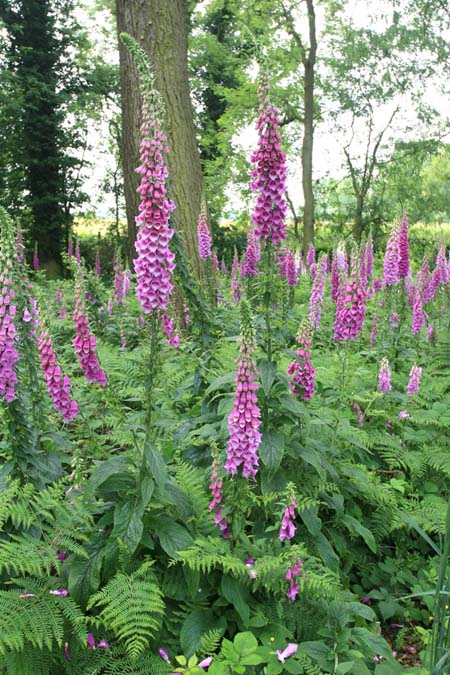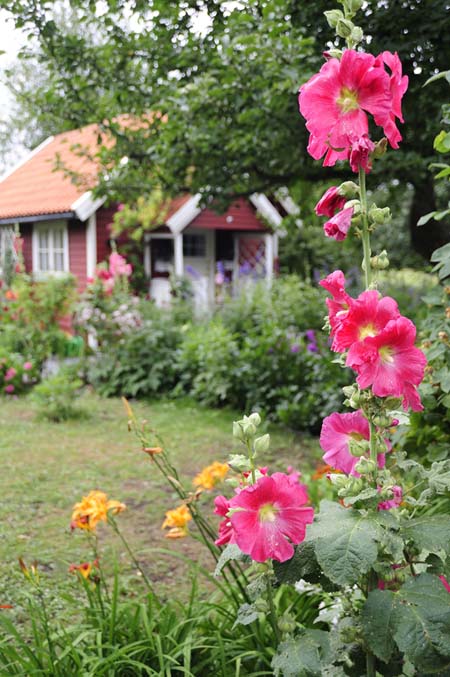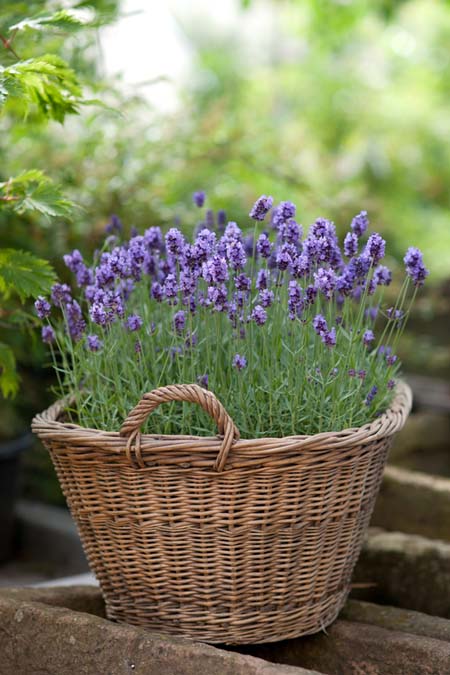Time-consuming demands on today’s busy homeowners don’t leave much spill-over for outdoor necessaries such as mowing, fertilizing, mulching, and weeding, let alone flower gardening! So you might think the very idea of attempting one of those flower-filled, meandering, paths-crossed, bench-friendly cottage gardens is ludicrous. But you’d be wrong! Now, even the busiest weekend gardener can stop to smell the roses. And the sweet peas. And the bee balm. And the cottage pinks. And the peonies. The best news? You won’t suffer burnout for the effort. Forget babysitting tidy rows of tiny marigolds or hoeing down weeds around puny peppers. Put your energy into turning that time-consuming, picture-perfect front lawn and its orderly floral border into a twining, climbing, delightfully dissembling cottage garden! Think about it: Cascading confections of dusty pink and red climbing roses… a tall sea of blue-gray Russian sage… masses of bright blue forget-me-nots… fragrant magenta peonies… towering hollyhocks … tall, lusciously pearled foxgloves… the ever-faithful and quite prolific black-eyed Susan… the perennial offerings today are as varied as they are enticing! Sounds like a lot of work, but it’s not. Maintenance-free is the watchword for today’s weekend gardeners, just as it was for the cottagers who devised and perfected this style of gardening several hundred years ago.
Un-Planning for the Over-Managed Lifestyle
The original cottage gardens were riots of color and fragrance, welcoming of “wildlings” – native flowers and vegetables grown from scavenged seeds by enterprising families who lived along main thoroughfares in the early days of the Industrial Revolution. The local cottage dwellers eked out their meager livings by selling home-crafts, homespun linens and woolens, fruits, vegetables, soaps, honey, floral bouquets, and other handmade items. They raised their own food, made their own flour, spun their own flax and fabrics, caught the fish and fowl they needed… who had time to worry about a lawn? But a pleasant first impression from ever-increasing trade that traveled the thoroughfares often meant the difference between attracting the carriage trade to stop and buy the cottagers’ wares… or trot on by. To save time, neighbors traded seeds and plants, and bartered what they couldn’t find in the wild, then simply scattered the collected seeds alongside the meandering path that led from the roadway to the cottage. Nature did the rest, with even the annuals reseeding themselves each year, until the cottage garden bloomed in glorious disarray, year after year.
Plan Your Unplanned Cottage Garden Now
You need just a tad of planning effort now – and you can do that on a comfy cushion in front of a TV or a flickering fireplace – for the ultimate payoff of a luxurious garden this summer. First, if you don’t recognize the flowers and plants proposed here, then grab a gardening book and look them up. Jot down your favorite bloomers, your edibles, and your hardy “talls” and “textures” for three-season color and bare winter interest. Not wild about weeding? Think masses. Lots of bloomers love a crowd! They’ll reward you by filling in fast, spreading out quickly, and blocking sunlight from reaching the ground below. You’ll want to pick a mix: some that bloom early, some that look lively for the long haul, and some that stay late! While a huge variety of plants will suit cottage gardening, no authentic cottager was without honeysuckle, hollyhocks, shrub or climbing roses, lavender, and pinks. Today’s sunny cottage garden also includes masses of gorgeous spreading daylilies, bee balm, sedum (‘Autumn Joy’ is a favorite), Gold Plate Achillea, black-eyed Susans, Russian sage, morning glories, and catmint. Even the northern climes can share the profusion. Fabulous sweet peas clambering up a fencepost, and masses of fragrant peonies, poppies, daisies, and asters are among cottage-style perennials winter-hardy enough for even the upper-tier states. Planting them close together early in the season keeps the weedlings from getting a grip in the soil. When your cottagers bloom en masse, they’ll block the sun. Without sun, weeds can’t flourish! Interplant your edibles in the sun as well. Violets, basil, marjoram, peppermint or other mints, nasturtiums, oregano, garlic, sweet peppers, and tomatoes will do nicely in any cottage-style setting. Scarlet runner and pole beans look striking
Burdened with Shade? Count Your Blessings!
The gracefully lush foxglove has offered shady spots spectacular vertical interest since the mid-1600s. Today, it makes a stunning complement to natural garden paths that you’ll find characterize your cottage garden sooner or later. Along with foxgloves, let your shade and partial shade take to flower unchecked with daylilies, primrose, and impatiens. Trollius, a sunny yellow buttercup that can grow two feet high, is a compliant spreading plant that tolerates partial shade and loves damp, humus-rich soil. Bleeding hearts are also beloved by busy cottage gardeners, because their graceful, fernlike foliage retires so quietly when the plant’s blooms are spent. This perennial offers white or pink heart-shaped rows of blossoms, with a blood-red “droplet” on each side, the blossoms nodding gently on arching stems. And of course, you have your ubiquitous shade plant, the various forms of the hosta, to fill in underneath the canopy.
Your Garden Guide: Taste and Passion
In many urban neighborhoods, the unplanned color riots and sweetly fragrant disorder of the genuine cottage garden have yielded to a more planned and orderly placement. But whether wild and free, or more restrained and managed, let your own individual taste and passion create your unique garden style. So whether your patch of heaven flourishes on 10 fertile sun-drenched acres, or on a sturdy 5-by-6 apartment balcony, with the miracle of soil, sun, and water, you can still shed your workday edge in a deliciously lush, enchantingly individual cottage-style greenspace. What’s your favorite addition to the cottage garden? Are you more about color, fragrance, meandering pathways, or tranquil spots to sit? Let us know what tickles your fancy in the comments below! © Ask the Experts, LLC. ALL RIGHTS RESERVED. See our TOS for more details. Uncredited photos: Shutterstock.



